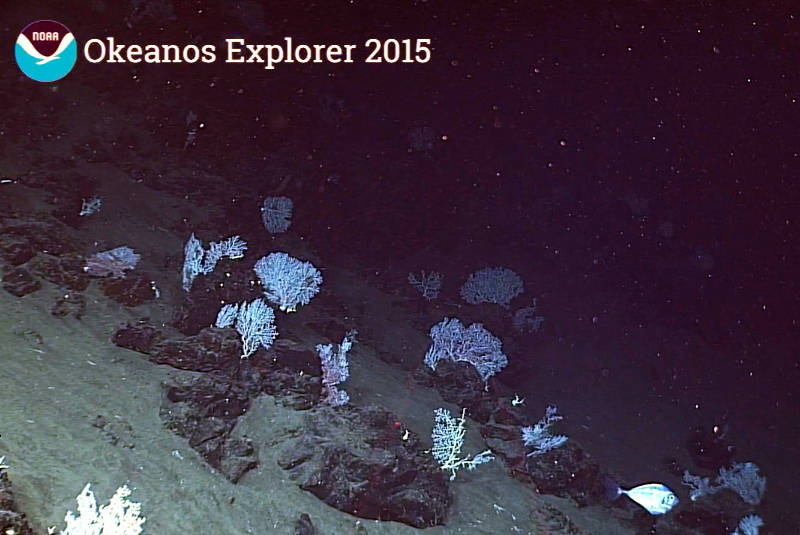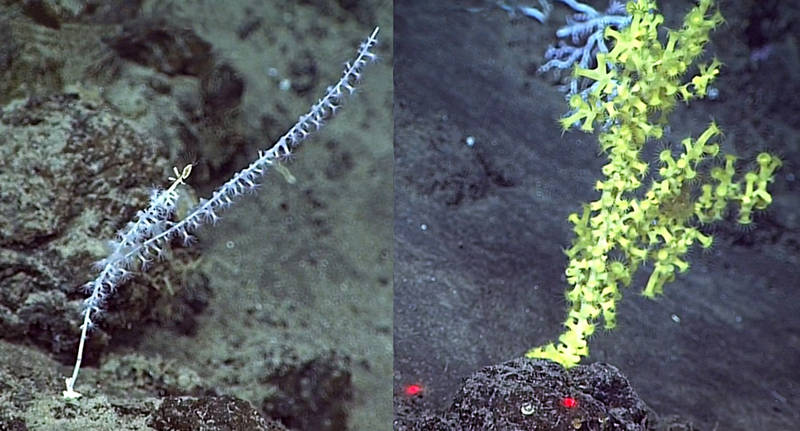
By Meagan R. Putts - Hawaii Pacific University
August 30, 2015

Photo of dense red and pink coral (Coralliidae) beds on the western branch of the 1986 Mauna Loa lava flow. Image courtesy of the NOAA Office of Ocean Exploration and Research, 2015 Hohonu Moana. Download larger version (jpg, 373 KB).
There are four types of precious coral in Hawai‘i: black coral (Antipathidae), gold coral (Kulamanamana haumeaae), red or pink coral (Coralliidae), and bamboo coral (Isididae). These corals are extremely long lived (some species have been known to live over 2,000 years) and are slow growing, with many individuals exhibiting growth rates less than a millimeter per year. Such longevity and slow growth rate suggest that deep-water precious coral communities develop extremely slowly, making them very difficult to study within a human lifetime.

Young bamboo coral (Isididae) colonizing a rock (right). Gold coral (Kulamanamana haumeaae) after fully colonizing a young bamboo coral skeleton (left). The laser points (red dots) are 10 centimeters (~4 inches) apart and are used to determine coral size. When gold coral planula larva attaches to and the colony eventually subsumes the host is the fastest growth phase of the coral as it must stabilize the skeleton and secure the base to avoid toppling which could result in colony death. Image courtesy of the NOAA Office of Ocean Exploration and Research, 2015 Hohonu Moana. Download larger version (jpg, 470 KB).
In Hawaii, lava flows on the Big Island provide a unique opportunity to examine the development of these coral communities across time. Each lava flow represents a severe disturbance event that marks the birth of a new coral community in the area where the flow occurred while inhabited areas to either side of the new flow are left undisturbed.
The age of large lava flows entering the sea from Hawaii have been accurately recorded by scientists for over 200 years. For lava flows that occurred prior to modern observations, radiocarbon dating of charcoal from beneath the lava has provided a detailed prehistoric eruptive history. Since the age and extent of the lava flows are well known, we can compare coral communities on successively older lava flows as well as “young” communities to “undisturbed” control communities adjacent to each flow. This allows us to reconstruct a general timeline for community development.
Prior to the 2015 Hohonu Moana expedition by NOAA Ship Okeanos Explorer, three Mauna Loa lava flows were surveyed in 2011 by the Hawaii Underwater Research Laboratory (HURL) submersible, Pisces V, conducting constant depth transects at 400 and 450 meters:
This study revealed that the first arrivals on fresh lava fields are relatively fast-growing red and pink coral species. Second to arrive were black coral along with other gorgonians, such as bamboo coral. Gold coral, the slowest growing of the precious corals, was the last to colonize the lava flow because it is an epizoic species, meaning that it uses other coral, specifically mature bamboo coral, as a colonization substrate.

ROV arm collecting a rock sample from the 1868 lava flow in order to confirm the age of the substrate using geochemical ratio and weathering analysis. The laser points (red dots) are 10 centimeters (~4 inches) apart and are used by scientists to determine the sizes of things that they are seeing. Image courtesy of the NOAA Office of Ocean Exploration and Research, 2015 Hohonu Moana. Download larger version (jpg, 391 KB).
The remotely operated vehicle (ROV) dive on the western branch of the 1968 lava flow was designed to be comparable to the 2011 submersible dives in order to add valuable data to the study. The focus of the dive is to confirm the age of the substrate based on dating collected rock samples and to improve our understanding of the timeline of colonization for gold coral colonies on historic lava flows. The primary challenge of the dive was maintaining the ROV at a consistent depth of 450 meters throughout the length of the dive. Also, in order to complete the two-kilometer transect across the lava flow, time spent stopping for close-ups and observation of non-target species had to be limited.